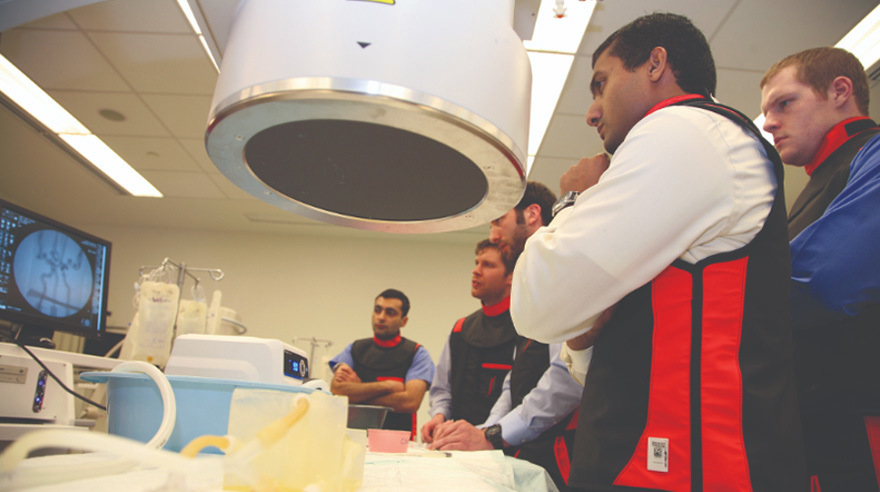Surgical education and training previously relied on textbook illustration, 2D scans, animal testing and an apprenticeship model that involved long obsevation periods prior to hands-on experience with rare procedures. Recent 3D printing advances provide doctors and researchers the tools to create patient- and condition-specific anatomy models for education and research. “We use 3D printing technology and materials to create a lifelike vascular environment that isn’t achievable any other way,” said Mike Springer, director of operations and entrepreneurship at the Jacobs Institute.
Instead of waiting to train on new procedures, physicians at the Jacobs Institute use 3D printed models of patients with stroke, clots, aneurysms and other pathologies to develop surgical skills in a no-risk environment. Models are customized to present a range of anatomies so physician participants are exposed to the limits of what they will see when treating living patients. “3D vascular models represent a new paradigm for training the next generation of doctors.
This paradigm includes surgical and endovascular simulation and skills evaluation before they are allowed to treat patients,” said Dr. L. Nelson Hopkins, founder of the Jacobs Institute and the Gates Vascular Institute. Training on 3D printed models can be done virtually anywhere, avoiding the cost and complexity of operating in the controlled environments required for animals and human cadavers.
Facilities with bio-hazard controls, refrigeration storage or on-site care are not required, lowering training costs significantly. Additionally, 3D printed models can mimic a range of tissues more realistically than processed cadavers, which no longer retain the feeling of live tissue. The models can incorporate access points, sensors and blood-flow simulation, enabling highly dynamic and interactive training. Complications can be designed into the model to ensure the first time a trainee faces a complex challenge is not with a patient on the table.
3D printing enables the Jacobs Institute to accelerate and improve medicaldevice design. The team at CTRC also facilitates preclinical testing for product validation using customized anatomical models to capture feedback on device performance. The sooner medical-device manufacturers gain insight into clinical performance and device interactions with patient anatomy, the faster they can respond with design changes before clinical trials. Preclinical validation testing is greatly improved when physicians can evaluate devices in realistic anatomical models that accurately simulate clinical performance.
“Recently we tested how effectively a particular device could reach the brain depending on tortuosity of the anatomy. We designed a series of models with differing levels of tortuosity, then tested the devices,” said Dr. Adnan Siddiqui, chief medical officer at the Jacobs Institute, vice chairman and professor of neurosurgery at University at Buffalo Neurosurgery, and director of neurosurgical stroke service at Kaleida Health. “This is impossible to do in animals and patients, but 3D printing makes it easy in a smooth, streamlined process.” In addition to improving new devices’ performance in treating patients, the early feedback that designers glean from real-anatomy testing lets them avoid costly, potentially unsuccessful animal testing.
When preparing for the most challenging cases referred to GVI and CTRC, physicians look to 3D printing. Using the same techniques developed in making anatomical models for training and device testing, staff at the Jacobs Institute take patient scans and create physical models to plan procedures, communicate with surgical teams, educate patients and their families, and practice the procedure before entering the operating room. Converting real patient-derived anatomy into realistic 3D models allows physicians to integrate visual and tactile clues into their surgical plan.
“3D printing is valuable in planning complex procedures with a team. Without it we prepare for complications on a theoretical basis,” said Vijay Iyer, M.D., Ph.D. “Many times, despite the best theoretical planning, we are faced with circumstances where we don’t know what to do.”
Physical models allow the team to test theories and reveal potential complications before the patient is on the table and time is critical. In a recent case treating a female patient with a brain aneurysm, the team was able to evaluate the suitability of their surgical solution before implementation.
“Originally our plan was to treat her aneurysm with a metallic basket called a web device that we would deliver into the aneurysm using a tiny tube. In this case, we were able to try to deploy that web device and found it wasn’t going to work. Based on the 3D model, we were able to preempt potential complications and devise a much more optimal means of treating the aneurysm,” said Dr. Siddiqui.
Ciprian Ionita, Ph.D., is a research assistant professor of biomedical engineering and neurosurgery at University at Buffalo. His team at the Jacobs Institute regularly uses a 3D printer to create custom fixtures for scientific equipment and experiments. “Using our in-house printer, we don’t rely on external machine shops that would generate both lag time and expense. Most of these fixtures and components can be 3D printed within a few hours,” said Dr. Ionita. PolyJet™ technology’s signature high resolution delivers the accuracy needed in the lab.
For high-tech X-ray components, the team designed and 3D printed an enclosure that holds an electron-multiplying change coupling device, the optic-transmission optics and the electronics for the Peltier cooling system. The system must operate at near zero degrees Celsius while ensuring perfect optical coupling, and printing using the Durus 3D printing material can accommodate this temperature change. Dr. Ionita’s research team has also 3D printed custom enclosures for a microCT system, holders for tissue scanning and sectioning and other devices to aid in lab research, quickly and without costly outsourcing.




